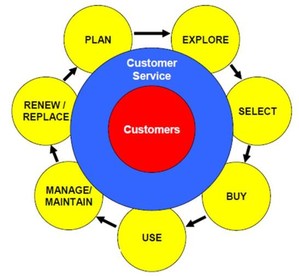Customer Portals: Central to Your Customer Experience Strategy
Customer Portals Support Your Customers throughout Their Lifecycles
There are three reasons why customer portals are hot: 1) you save money by enabling customers to serve themselves and to up-sell and cross-sell themselves; 2) you increase customer satisfaction, loyalty, and profitability by providing everything the customer needs in one convenient, custom-tailored environment; and 3) you gain visibility into customers’ account information, their needs, and their preferences. By using customer portals to enable customers to manage their own relationships, you “solve” the problem of having a 360-degree view of your customers’ information—long the holy grail of CRM.
WHAT ARE CUSTOMER PORTALS? AND WHY ARE THEY HOT?
Customer Portals Are Strategic to Your Business
Customer portals are hot! Customer portals offer the most effective mechanism for making it easy for customers to do business with you. They improve the customer experience while lowering your costs to serve.
Instead of forcing customers to traverse different Web sites and multiple logons to explore, buy, use, maintain, upgrade, renew, or replace products and services, savvy companies now offer their customers a single portal they can use to manage their end-to-end relationships throughout the customer lifecycle. The advantage to the customer is convenience and relevance—everything she needs is in one place, and the customer sees only those products and services that are relevant for her context.
Benefits from Customer Portals
Why are customer portals hot? Three benefits of customer portals to your company are:
• You save money by enabling customers to serve themselves and to up-sell and cross-sell themselves.
• You increase customer satisfaction, loyalty, and profitability by providing everything the customer needs in one convenient, custom-tailored environment.
• You gain visibility into customers’ account information, their needs, and their preferences.
The requirement to offer customer self-service isn’t new. What’s new is the desire on the part of customers to manage their relationships, to have visibility into their account information and transaction histories, to be able to surround the products they’ve purchased with information and services, and to streamline their interactions.
What gets us (and many of our clients) excited about using customer portals to enable customers to manage their own relationships is that it “solves” the problem of having a 360-degree view of our customers’ information—long the holy grail of CRM. By giving customers access to their account information and to all the tools and resources they need to manage their own relationships, we take a giant leap forward in the insights we gain about customers’ accounts, contexts, and needs. That’s why customer portals are hot: They make customers happy by letting them serve themselves, and they give us tons of information about our customers’ accounts as a byproduct.
Customer Portals Defined
We define portals as user experiences, targeted at specific constituencies, that perform the following tasks:
• Portals aggregate and deliver information from a variety of internal and external resources.
• Portals wrap up and present application func-tionality from existing internal IT systems and from external applications.
• Portals enable single sign-on and authentication for the applications and resources that end users access via the portal.
• Portals offer customization capabilities to portal owners and basic personalization capabilities to end users.
Customer portals extend this definition as follows:
• The audience for customer portals is a specific group of customers—for example, small business customers or individuals in a specific client account.
• The information and application functionality that are supplied by a customer portal give customers access to their own account information and transaction and interaction histories, and they support customers’ interactions and transactions throughout their entire lifecycles—plan, explore, select, buy, use, maintain, renew/replace. (See Illustration.)
• Role-based portal access (via single sign-on) determines the particular Customer Scenarios® that are featured on the portal.
Customer Portals Provide Cross-Lifecycle Customer Self-Service
© 2005 Patricia Seybold Group Inc.
Illustration 1. This illustration shows the phases of the customer service lifecycle around the core of (customer) support and a focus on the customer, represented by the proxy of your customer information.
Customer Portals Span the Customer’s Lifecycle
Many business people now commonly use the term “customer portals” to describe a Web site that is designed for a particular account; a particular group of customers; or a particular customer segment, geography, or culture. Ideally, a customer portal should support a customer through his entire lifecycle in dealing with your company and its products and services—from planning through purchase; through maintenance and support; to upgrades, renewals, or replacement.
PROVIDE A SINGLE “PLACE” FOR SUPPORT, TRANSACTIONS, ACCOUNT MANAGEMENT, AND MORE. Instead of separating product marketing information, ecommerce transactions, and cus-tomer support functionality into separate Web sites, customer portals typically aggregate all of the different scenarios a particular customer set may need in one convenient location. One portlet might contain the customer’s product information—what products she owns or has purchased in the past. Another portlet might provide access to the customer support diagnostic tools, information, and resources that are relevant to the customer’s products. A third portlet might offer complementary services or add-on products for sale.
PROVIDE CUSTOMER-SPECIFIC SCENARIOS. Each audience-specific portal ideally contains the most common Customer Scenarios used by that group of people. So, for example, at a portal de-signed to support customers that are small businesses, customers could accomplish the following...
Sign in to download the full article
0 comments
Be the first one to comment.



